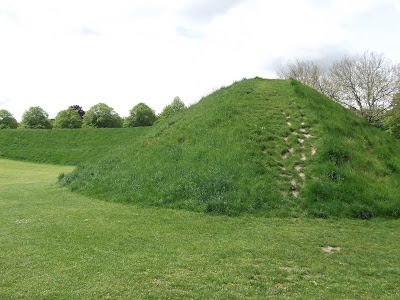There can be few towns in literature as
readily identifiable with their real life counterparts as Casterbridge, Thomas
Hardy's fictional version of Dorchester. The town is the focal point of The Mayor Of
Casterbridge, the story of a man, Michael Henchard, who drunkenly sells his wife in his youth. This act comes back to haunt him later in life, by which time he has become the Mayor Of Casterbridge. The story makes numerous references to
local landmarks and buildings which can be pinned down to their real-life
equivalents. One of Dorchester's
best known features is The Walks, a series of pleasant, tree-lined avenues
which follow the line of the original Roman walls. In Hardy's time, these avenues more or less
formed the boundary between the town and the countryside, and there are several
references to the way in which the agricultural areas around the town almost
encroached on its streets. Hardy
describes the town as "like a chessboard on a green table-cloth", and
he talks of how, when an execution took place, the cows had to be moved out of
the way from the meadow next to the "drop" to make way for the
spectators. And how the judge, when
passing sentence, did so "to the tune of Baa", from the sheep nearby. Meanwhile, the High Street was colonised by
pig-dealers occupying the recesses outside people's houses, and by the sellers
of horses who "occasionally nipped little boys by the shoulder who were
passing to school". Needless to
say, the present-day Dorchester has spread far
beyond the confines of The Walks.
Halfway up Dorchester's
High Street is the Kings Arms Hotel (now closed), an inn built in 1720 which has played host
to Queen Victoria and King George VI.
The hotel, with the same name, features prominently in The Mayor Of
Casterbridge (and also appeared in Far From The Madding Crowd). Many of the important events of the novel
take place in the Kings Arms. In chapter
5 the Mayor of the title presides over "a great public dinner of the
gentlepeople and such like leading volk", with the town band playing
outside and lesser townsfolk peering in through the windows at the proceedings
therein. This is the point at which the
sold wife first sees her husband after a long separation. Another prominent pub which features in the
story is The Three Mariners - this was based on an inn called The King Of
Prussia, which was pulled down at the end of the 19th century.
 | |
| The house reputed to have been lived in by Michael Henchard. Photo by Brian Turland |
 | |
| The Kings Arms. Photo by Brian Turland |
As well as the town itself, several nearby
landmarks play an important part in the story. As its name suggests, Dorchester
had Roman origins, and there are many relics of that time around the town. Maumbury Rings was the site of a Roman
amphitheatre in the 1st century AD. The
site, which is referred to as the Ring in the novel, is where Henchard has a
rendezvous with his former wife, and later with the other woman in his life,
Lucetta. There is a road referred to in the story as
the Via, so called because it was once a Roman road. This Via is overlooked by Maiden Castle - or
Mai Dun - the largest prehistoric earthwork in the country, which is used as a
vantage point by Henchard to observe comings and goings along the Via. Some of the more rural scenes in the novel are
set in "an eastern purlieu" called Durnover. This is a fictional village on the edge of
town, of which the real-life equivalent is Fordington, a former village which
now forms part of the built-up area of Dorchester. Further afield, the seaside town named
Budmouth in the novel is Hardy's version of Weymouth, which also appears
elsewhere in his work.
 | |
| Maumbury Ring. Photo by Brian Turland |
 | ||||
| Fordington, aka Durnover. Photo by Brian Turland |
Hardy was well qualified to base a novel
around Dorchester: he was born in Higher Bockhampton near the town in 1840, and
in 1849 began attending a school in Dorchester. At 16 he went to work for the architect John
Hicks, at 39 South Street. Later in life, after spending time in London and a variety of locations he returned to live in Dorchester, moving into Max Gate in 1885. This Victorian house designed by Hardy himself
is now run by the National Trust, who also run his Higher Bockhampton
birthplace. Near Dorchester, commanding an elevated position with views out to the coast and inland, is the Hardy Monument, also National Trust.
 |
| Thomas Hardy's Birthplace (8061936623). Photo by Peter Broster, via Wikimedia Commons |
 | |
| Thomas Hardy's statue. Photo by Brian Turland |
For tourist information about Dorchester follow this link.
Map of the town.
No comments:
Post a Comment